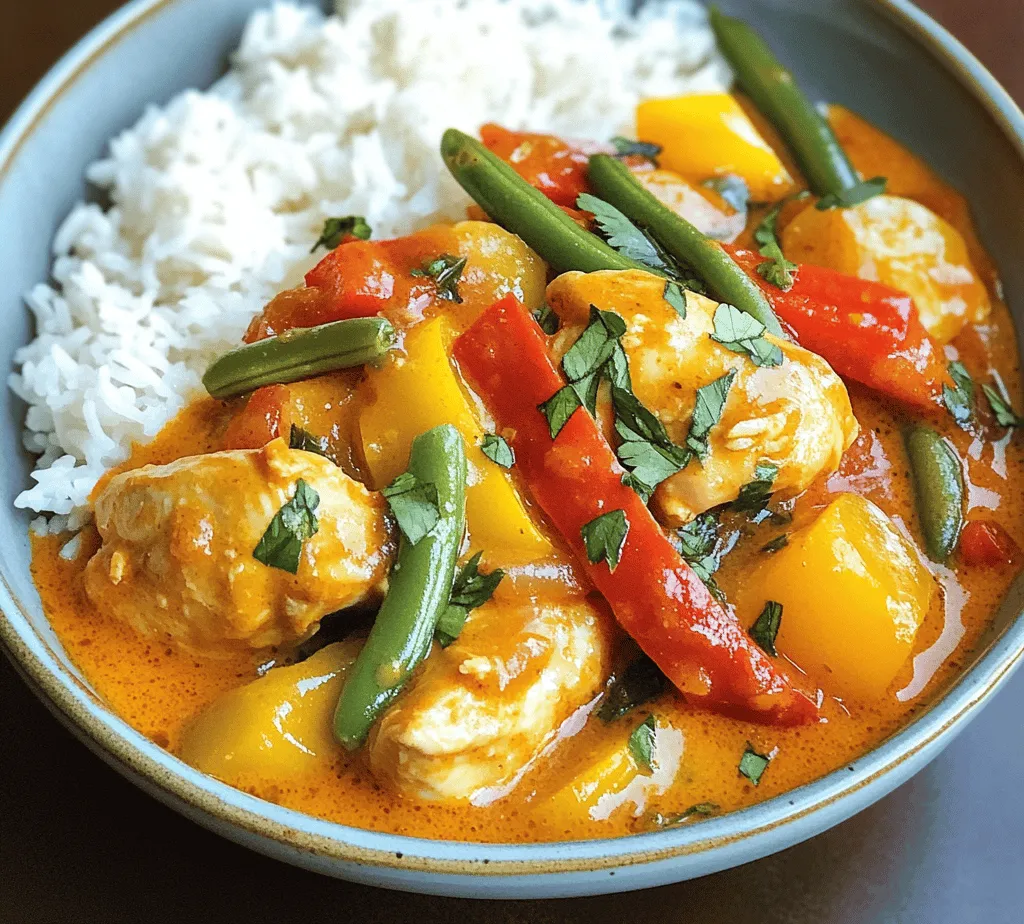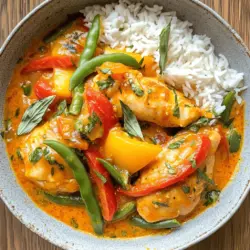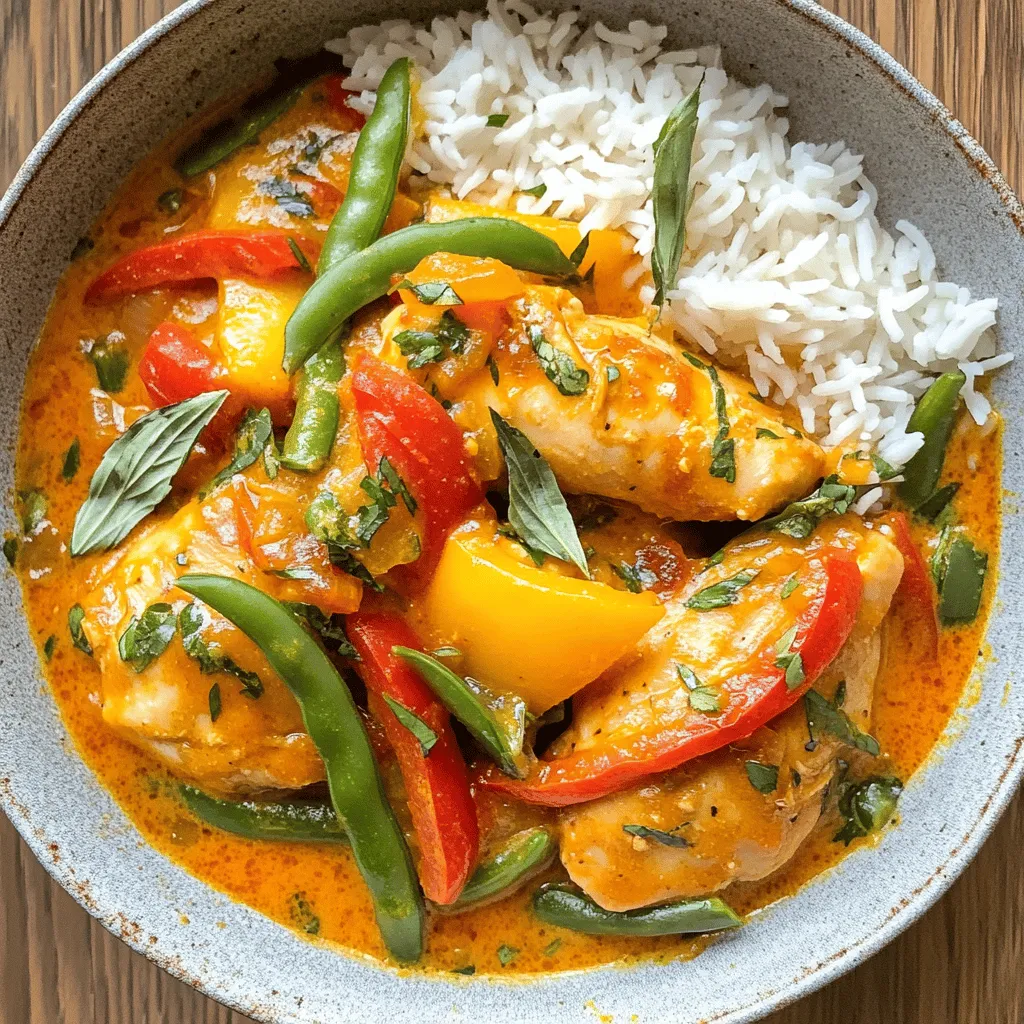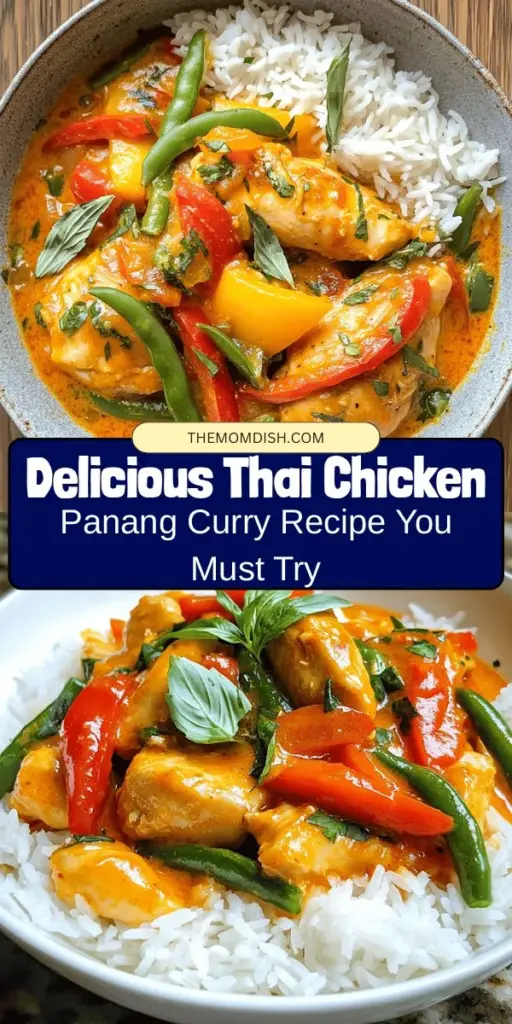Introduction
Thai cuisine is renowned worldwide for its vibrant flavors, aromatic herbs, and complex combinations of sweet, salty, spicy, and sour. It’s a culinary tradition that beautifully reflects Thailand’s rich culture and history, attracting food lovers from all walks of life. Among the many dishes that make Thai cooking famous, Panang curry stands out for its unique flavor and creamy texture, making it a favorite among curry enthusiasts.
Panang curry is a type of Thai curry that is thicker and more aromatic than its counterparts, such as red and green curry. What sets it apart is its use of Panang curry paste, which infuses the dish with a distinctive taste profile that balances the richness of coconut milk with a medley of spices and herbs. This delightful curry is typically served with tender chicken, making it a satisfying and hearty meal.
One of the hallmarks of Thai cooking is the emphasis on using fresh ingredients. The quality of these ingredients can make a significant difference in the final dish, enhancing the authentic flavors that Thai cuisine is celebrated for. In this recipe, you can expect to learn not only how to make the best Thai Chicken Panang Curry but also the key ingredients and techniques that will elevate your cooking and transport your taste buds straight to Thailand.
Understanding Panang Curry
Definition and Origin of Panang Curry
Panang curry, or “Panaeng,” is believed to have originated from the central region of Thailand and is named after the city of Penang in Malaysia, highlighting the cultural exchange that has shaped this dish over the years. Unlike the more commonly known red and green curries, which are made with distinct curry pastes derived from different ingredients, Panang curry is characterized by its thicker consistency and its use of less liquid. This results in a richer, creamier sauce that clings beautifully to the protein of choice.
Differences Between Panang Curry and Other Types of Thai Curries
While red and green curries are widely popular and feature different types of chili peppers and herbs, Panang curry distinguishes itself with its unique flavor profile. Red curry is typically spicier and made with red chili paste, while green curry is known for its vibrant color and fresh herbal notes, derived from green chilies and basil. In contrast, Panang curry is less focused on heat and instead highlights the sweetness of coconut milk and the aromatic qualities of its spices.
The key ingredients in Panang curry paste include dried red chilies, garlic, lemongrass, galangal, and kaffir lime leaves, which give the dish its signature flavor. This blend creates a harmonious balance of spices that defines Panang curry, making it a comforting yet sophisticated option for dinner.
Key Ingredients that Define Panang Curry Flavor Profile
The distinctive taste of Panang curry comes from a combination of its core ingredients. The richness of coconut milk provides a creamy base, while the Panang curry paste delivers aromatic spices that tantalize the palate. Fresh herbs, such as kaffir lime leaves, add a burst of freshness, while the sweetness from sugar balances the saltiness of fish sauce. These elements work together to create a delightful medley of flavors that is both satisfying and memorable.
Ingredients Breakdown
Overview of Each Ingredient in the Recipe
To make the best Thai Chicken Panang Curry, it’s essential to gather high-quality ingredients that will contribute to the dish’s flavor and texture. Below is a breakdown of the key components you will need:
– Boneless, Skinless Chicken Thighs: This cut of chicken is ideal for curry due to its tender texture and ability to absorb flavors. Unlike chicken breasts, which can dry out when cooked, thighs remain juicy and flavorful, making them perfect for slow-cooking in rich sauces.
– Panang Curry Paste: This is the heart of the dish. When selecting a Panang curry paste, look for brands that use natural ingredients, with no artificial preservatives. You can often find it in Asian grocery stores or specialty shops. Alternatively, you can make your own paste, but store-bought versions save time without sacrificing flavor.
– Coconut Milk: A staple in Thai cooking, coconut milk adds creaminess and a subtle sweetness to the curry. For an authentic taste, use full-fat coconut milk. If you’re looking for a lighter option, you can substitute with light coconut milk, although this may alter the overall richness of the dish.
– Fish Sauce and Sugar: Fish sauce is essential in Thai cuisine, providing a salty umami flavor that enhances the overall taste of the curry. Sugar, often palm sugar, is added to balance the saltiness and acidity, creating a well-rounded flavor.
– Vegetables: Red bell pepper and green beans are commonly used in Panang curry. Red bell peppers add sweetness and a pop of color, while green beans offer a crisp texture and nutritional benefits, including vitamins A and C.
– Kaffir Lime Leaves: These aromatic leaves are vital for adding a fresh, citrusy note to the curry. They are often used whole and removed before serving or finely shredded to infuse flavor. Fresh kaffir lime leaves are preferable, but dried leaves can be a substitute in a pinch.
Suggestions for Sourcing Ingredients
When it comes to sourcing the ingredients for your Panang curry, freshness is key. Visit local Asian markets for authentic products, and don’t hesitate to ask staff for recommendations on the best brands. Fresh herbs, especially kaffir lime leaves, are best purchased from farmers’ markets or specialty grocery stores. If you can’t find specific items, consider looking for online retailers that specialize in Asian ingredients.
Preparation Steps Explained
Step-by-Step Guide to Preparing the Recipe
Now that you have a solid understanding of the ingredients, it’s time to dive into the preparation of the best Thai Chicken Panang Curry. Below are the essential steps you’ll follow to create this delicious dish.
1. Prepare the Ingredients: Start by gathering and prepping all your ingredients. Slice the boneless, skinless chicken thighs into bite-sized pieces. Wash and cut the red bell pepper into strips, and trim the ends of the green beans. If you have fresh kaffir lime leaves, tear them to release their oils.
2. Heat the Oil: In a large skillet or wok, heat a tablespoon of vegetable oil over medium heat. It’s crucial to get the oil hot but not smoking, as this will allow the curry paste to bloom properly, releasing its flavors into the oil.
3. Cook the Curry Paste: Once the oil is hot, add the Panang curry paste, stirring it into the oil for about a minute. This step is vital, as it will deepen the flavors and aroma of the paste, creating a fragrant base for your curry. Keep stirring to prevent the paste from sticking or burning.
4. Add the Chicken: After the curry paste is fragrant, add the sliced chicken thighs to the skillet. Stir well to coat the chicken with the paste and cook for a few minutes until the chicken is no longer pink on the outside. This initial searing will lock in the flavors and juices of the chicken.
5. Pour in the Coconut Milk: Once the chicken is lightly browned, pour in the coconut milk. Stir gently to combine the coconut milk with the curry paste and chicken. The coconut milk will create a luscious sauce, so make sure to scrape any bits from the bottom of the skillet to incorporate all the flavors.
6. Season the Curry: Add the fish sauce and sugar to the mix, stirring well to combine. Taste the curry and adjust the seasoning if necessary, keeping in mind that the balance of sweet and salty is key to achieving the authentic flavors of Thai cuisine.
7. Incorporate the Vegetables: Add the sliced red bell pepper and green beans to the curry. These vegetables not only enhance the dish’s flavor but also provide a beautiful color contrast. Let the curry simmer gently for about 10 minutes, allowing the vegetables to soften while the chicken finishes cooking.
8. Add the Kaffir Lime Leaves: Finally, add the torn kaffir lime leaves to the curry. Their aromatic scent will give the dish a fresh, citrusy boost. Allow the curry to simmer for an additional 5 minutes, ensuring the flavors meld beautifully.
By following these preparation steps, you will create a mouthwatering Thai Chicken Panang Curry that showcases the vibrant flavors of Thailand in each bite. Stay tuned for the next part of this article, where we will explore tips for achieving the best results and addressing common questions about this beloved dish.

Cooking the Curry Paste: How to Maximize Flavor Extraction
Making the perfect Thai Chicken Panang Curry begins with the curry paste, which is the heart of the dish. To maximize flavor extraction, it’s essential to take the time to properly cook the curry paste before adding other ingredients. Start by heating a tablespoon of vegetable oil in a large pan over medium heat. Once the oil is hot, add the curry paste. Sauté the paste for about 4-5 minutes, stirring frequently, until it becomes fragrant. This step is crucial as it helps to release the essential oils from the spices and herbs in the paste, intensifying the flavors of your curry.
Additionally, if you have access to freshly made curry paste or want to enhance the flavor further, consider adding a touch of freshly grated ginger or garlic while cooking the paste. These ingredients will contribute to a more robust flavor profile and add depth to your dish.
Adding Chicken: Tips for Even Cooking and Browning
Once your curry paste is aromatic, it’s time to add the chicken. Use boneless, skinless chicken thighs for the best results, as they remain moist and tender during cooking. Cut the chicken into bite-sized pieces and add it to the pan in a single layer. Avoid overcrowding the pan to ensure even cooking and browning. Let the chicken sear undisturbed for about 3-4 minutes before stirring. This step will help develop a lovely golden crust on the chicken, enhancing the overall flavor of the dish.
After the first browning, continue to cook the chicken for an additional 5-7 minutes, stirring occasionally, until it is cooked through. The chicken should be tender and fully cooked without being dry. This method ensures that every bite is juicy and flavorful.
Incorporating Coconut Milk: Techniques for a Creamy Texture
With the chicken perfectly cooked, it’s time to introduce the coconut milk, which is essential for achieving that signature creamy texture. Pour in a can of full-fat coconut milk and stir well to combine it with the curry paste and chicken. To prevent the coconut milk from curdling, reduce the heat to low after adding it. Gently simmer the curry for about 10-15 minutes, allowing the flavors to meld together beautifully.
For an extra creamy consistency, you can reserve about 1/4 cup of coconut milk and add it at the end just before serving. This technique enhances the richness of the curry without compromising the texture. Additionally, if you prefer a lighter version, you can substitute part of the coconut milk with chicken broth, which maintains the flavor while reducing calories.
Seasoning the Curry: Balancing Flavors with Fish Sauce and Sugar
Now that your curry base is developing, it’s crucial to achieve the right balance of flavors. Thai cuisine is known for its harmony of sweet, salty, and sour notes. Start by adding fish sauce to the curry—typically, 2 to 3 tablespoons should suffice. The fish sauce provides that essential umami flavor that is characteristic of Thai dishes.
To counterbalance the saltiness, add a teaspoon of sugar (palm sugar is preferred for authenticity). This will enhance the overall flavor and bring out the richness of the coconut milk. Taste and adjust these seasonings as necessary; everyone’s palate is different, and you may prefer a sweeter or saltier dish.
Adding Vegetables: Best Practices for Maintaining Texture and Color
For a well-rounded Panang curry, incorporating vegetables is vital. Popular additions include bell peppers, green beans, and carrots. Cut the vegetables into uniform pieces to ensure even cooking. Add them to the curry about halfway through the simmering process, around the 5-8 minute mark. This timing ensures that they remain vibrant and crisp rather than becoming mushy.
To maintain the bright colors and nutritional value of the vegetables, avoid overcooking them. The goal is to achieve a tender-crisp texture that complements the creamy curry. Stir gently to coat the vegetables in the sauce, allowing them to absorb the flavors of the curry while still retaining their freshness.
Finishing with Lime: Enhancing Aroma and Freshness
Just before serving, enhance your Thai Chicken Panang Curry with a splash of fresh lime juice. The acidity of the lime cuts through the richness of the coconut milk and adds a refreshing zing that elevates the dish. Squeeze the juice from half a lime directly into the curry and stir gently. This simple step will enhance the aroma and give your curry a bright, fresh flavor profile.
For an extra touch, consider garnishing with lime wedges when serving, allowing your guests to add more lime juice to taste. This finishing touch not only boosts flavor but also adds an appealing visual element to your dish.
Serving Suggestions
Pairing the Curry with Jasmine Rice: Importance of Rice in Thai Cuisine
No Thai meal is complete without rice, and Jasmine rice is the perfect companion for your Panang curry. Its fragrant aroma and slightly sticky texture make it ideal for soaking up the rich sauce. Cook the rice according to the package instructions, usually by rinsing it to remove excess starch and then cooking it in a rice cooker or on the stovetop.
To elevate the dining experience, serve the curry over a mound of fluffy Jasmine rice in shallow bowls. The contrast of the creamy curry against the white rice is visually appealing and enhances the overall enjoyment of the dish.
Ideas for Garnishing: Role of Fresh Thai Basil and Other Herbs
Garnishing your dish not only adds visual appeal but also introduces fresh flavors. Thai basil is a classic choice for Panang curry, providing a slightly spicy and aromatic note. Tear a few leaves and sprinkle them over the curry just before serving for an extra burst of flavor.
You can also consider garnishing with freshly chopped cilantro or thinly sliced red chili for those who enjoy a little heat. These fresh herbs not only enhance the aesthetic but also complement the complex flavors of the curry.
Suggestions for Side Dishes that Complement Panang Curry
To create a well-rounded meal, consider serving your Panang curry alongside traditional Thai side dishes. A fresh Thai salad made with crunchy vegetables and a tangy dressing can provide a refreshing contrast to the rich curry. Spring rolls filled with vegetables or shrimp also make an excellent accompaniment, offering a nice texture and flavor balance.
Another option is to serve a light soup, such as Tom Yum, which can enhance the overall dining experience with its contrasting flavors. These side dishes will round out your meal beautifully, making it a feast to remember.
Nutritional Information
Overview of the Nutritional Content of the Dish
When preparing Thai Chicken Panang Curry, you can expect a dish rich in flavors and nutrients. A typical serving (one cup) of Panang curry with chicken contains approximately 400-500 calories, depending on the amount of coconut milk used and any added ingredients.
Health Benefits of the Main Ingredients
The ingredients in this curry offer various health benefits. Chicken provides a high-quality source of protein, essential for muscle repair and growth. Coconut milk, while high in calories, contains medium-chain triglycerides (MCTs), which may boost metabolism and provide quick energy. Moreover, the spices in the curry paste, such as turmeric and chili, have antioxidant and anti-inflammatory properties.
Vegetables like bell peppers and green beans add fiber, vitamins, and minerals, contributing to overall health and well-being. When enjoyed in moderation, this dish can be a flavorful and nourishing part of a balanced diet.
Discussion on Portion Sizes and Serving Recommendations
For a balanced meal, one serving of Panang curry alongside a cup of cooked Jasmine rice is generally sufficient for an adult. However, portion sizes can vary based on individual dietary needs and activity levels. When serving, consider offering a variety of side dishes to allow guests to customize their plates, promoting a sharing experience that is central to Thai dining culture.
Cultural Significance of Thai Curry
The Role of Curry in Thai Meals and Celebrations
Curry plays a pivotal role in Thai cuisine, often serving as the centerpiece of family meals and festive gatherings. It embodies the essence of Thai cooking, reflecting the country’s rich agricultural heritage and the abundance of fresh ingredients. Celebrations, such as weddings and festivals, often feature elaborate curry dishes, showcasing the culinary skills and traditions of the region.
Personal Anecdotes or Quotes from Thai Chefs or Food Enthusiasts
Renowned Thai chefs often emphasize the importance of balance in their dishes. Chef David Thompson, a celebrated authority on Thai cuisine, states, “The essence of Thai cooking is the balancing of flavors—sweet, salty, sour, and spicy—each ingredient plays its part.” This philosophy resonates deeply in the making of Panang curry, where each component contributes to a harmonious dish.
How Panang Curry Reflects the Rich Culinary Heritage of Thailand
Panang curry exemplifies the unique blend of flavors and techniques that define Thai cuisine. It showcases the use of fresh herbs and spices, the importance of coconut milk, and the balancing of flavors—elements that are deeply rooted in Thailand’s culinary history. Enjoying Panang curry is not just about taste; it is an invitation to experience a piece of Thai culture and the stories that come with it.
Conclusion
In conclusion, making Thai Chicken Panang Curry is not only a straightforward process, but it also yields a dish brimming with flavor and cultural significance. The fusion of aromatic spices, creamy coconut milk, and tender chicken creates a culinary experience that is both satisfying and delightful.
We encourage you to try this recipe, as it allows you to explore the vibrant flavors of Thai cooking in your kitchen. Whether you’re preparing a family dinner or entertaining guests, this dish is sure to impress. Remember, the joy of cooking lies not just in the food, but in the shared experience with loved ones around the table. Embrace the art of Thai cuisine and enjoy the deliciousness of your homemade Panang curry.



